HI6005: Analyzing Corporate Culture and Organizational Dimensions
VerifiedAdded on 2022/09/25
|17
|4153
|22
Report
AI Summary
This report provides a comprehensive overview of organizational culture, defining it as the values, beliefs, and behaviors within an organization. It explores the characteristics of organizational culture, including structure, identity, management systems, conflict tolerance, performance reward systems, and individual autonomy. The report delves into various organizational dimensions, such as detail-oriented, aggressive, people-oriented, stable, team-oriented, and socially responsible cultures, illustrating them with real-world examples like Four Seasons, Reliance Jio, Zappos, and Google. It also discusses the importance of organizational culture and how it influences employee performance, highlighting the challenges in changing established cultures. The report concludes by summarizing the key aspects of organizational culture and its impact on organizational success. This analysis is crucial for understanding how different organizational dimensions shape the workplace environment and affect overall business outcomes. The report emphasizes the importance of adapting organizational culture to meet the demands of a global environment.
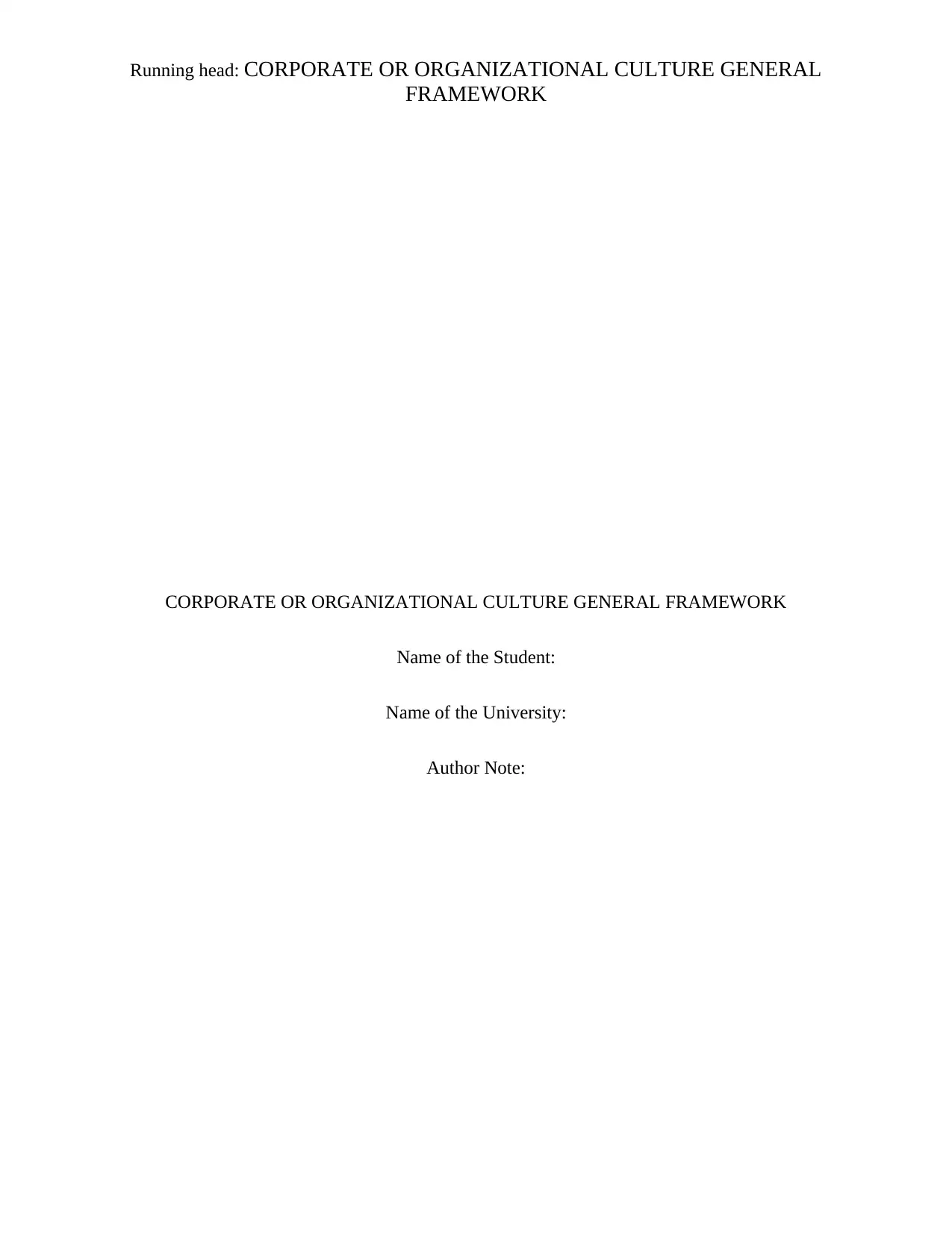
Running head: CORPORATE OR ORGANIZATIONAL CULTURE GENERAL
FRAMEWORK
CORPORATE OR ORGANIZATIONAL CULTURE GENERAL FRAMEWORK
Name of the Student:
Name of the University:
Author Note:
FRAMEWORK
CORPORATE OR ORGANIZATIONAL CULTURE GENERAL FRAMEWORK
Name of the Student:
Name of the University:
Author Note:
Paraphrase This Document
Need a fresh take? Get an instant paraphrase of this document with our AI Paraphraser
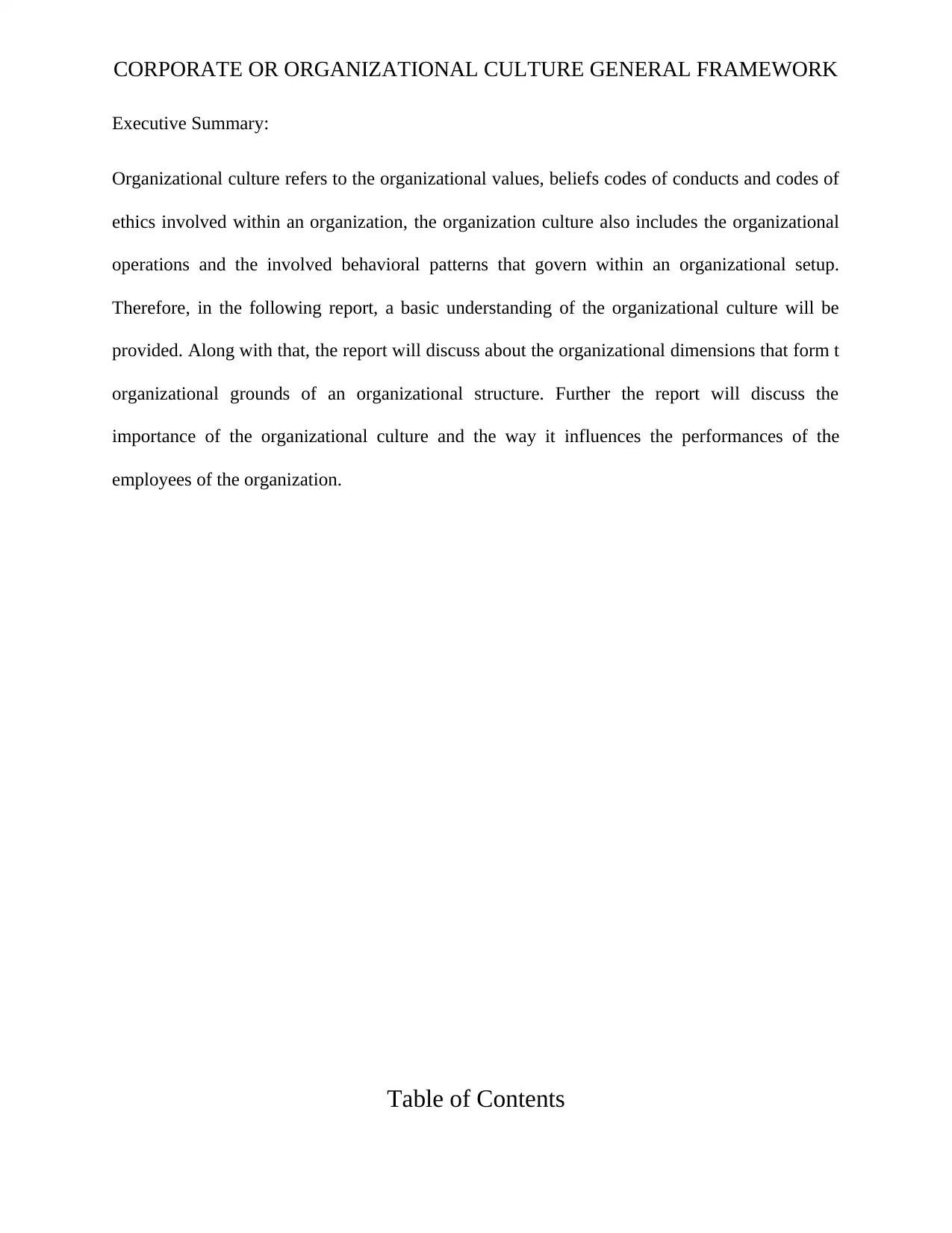
CORPORATE OR ORGANIZATIONAL CULTURE GENERAL FRAMEWORK
Executive Summary:
Organizational culture refers to the organizational values, beliefs codes of conducts and codes of
ethics involved within an organization, the organization culture also includes the organizational
operations and the involved behavioral patterns that govern within an organizational setup.
Therefore, in the following report, a basic understanding of the organizational culture will be
provided. Along with that, the report will discuss about the organizational dimensions that form t
organizational grounds of an organizational structure. Further the report will discuss the
importance of the organizational culture and the way it influences the performances of the
employees of the organization.
Table of Contents
Executive Summary:
Organizational culture refers to the organizational values, beliefs codes of conducts and codes of
ethics involved within an organization, the organization culture also includes the organizational
operations and the involved behavioral patterns that govern within an organizational setup.
Therefore, in the following report, a basic understanding of the organizational culture will be
provided. Along with that, the report will discuss about the organizational dimensions that form t
organizational grounds of an organizational structure. Further the report will discuss the
importance of the organizational culture and the way it influences the performances of the
employees of the organization.
Table of Contents
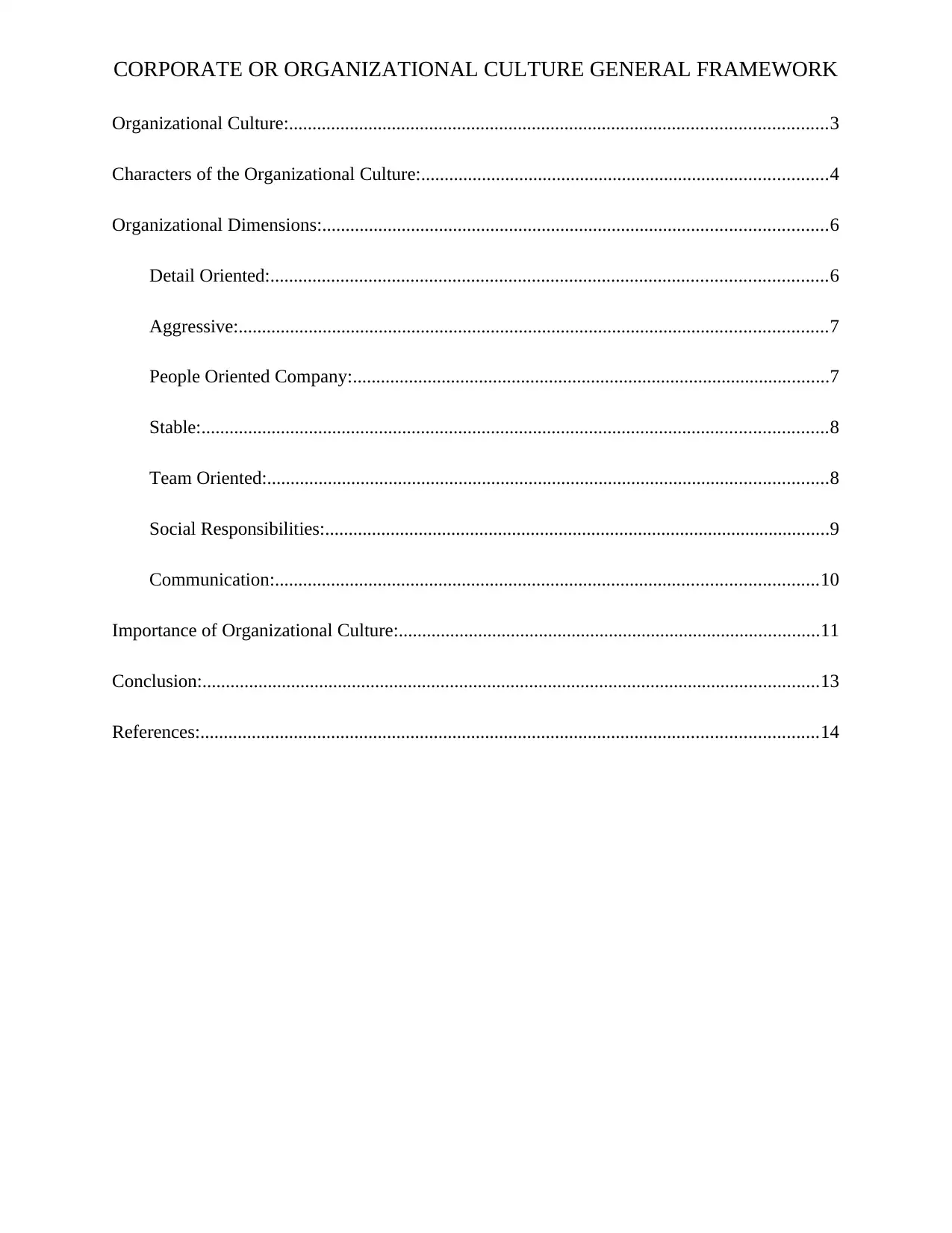
CORPORATE OR ORGANIZATIONAL CULTURE GENERAL FRAMEWORK
Organizational Culture:...................................................................................................................3
Characters of the Organizational Culture:.......................................................................................4
Organizational Dimensions:............................................................................................................6
Detail Oriented:.......................................................................................................................6
Aggressive:..............................................................................................................................7
People Oriented Company:......................................................................................................7
Stable:......................................................................................................................................8
Team Oriented:........................................................................................................................8
Social Responsibilities:............................................................................................................9
Communication:....................................................................................................................10
Importance of Organizational Culture:..........................................................................................11
Conclusion:....................................................................................................................................13
References:....................................................................................................................................14
Organizational Culture:...................................................................................................................3
Characters of the Organizational Culture:.......................................................................................4
Organizational Dimensions:............................................................................................................6
Detail Oriented:.......................................................................................................................6
Aggressive:..............................................................................................................................7
People Oriented Company:......................................................................................................7
Stable:......................................................................................................................................8
Team Oriented:........................................................................................................................8
Social Responsibilities:............................................................................................................9
Communication:....................................................................................................................10
Importance of Organizational Culture:..........................................................................................11
Conclusion:....................................................................................................................................13
References:....................................................................................................................................14
⊘ This is a preview!⊘
Do you want full access?
Subscribe today to unlock all pages.

Trusted by 1+ million students worldwide
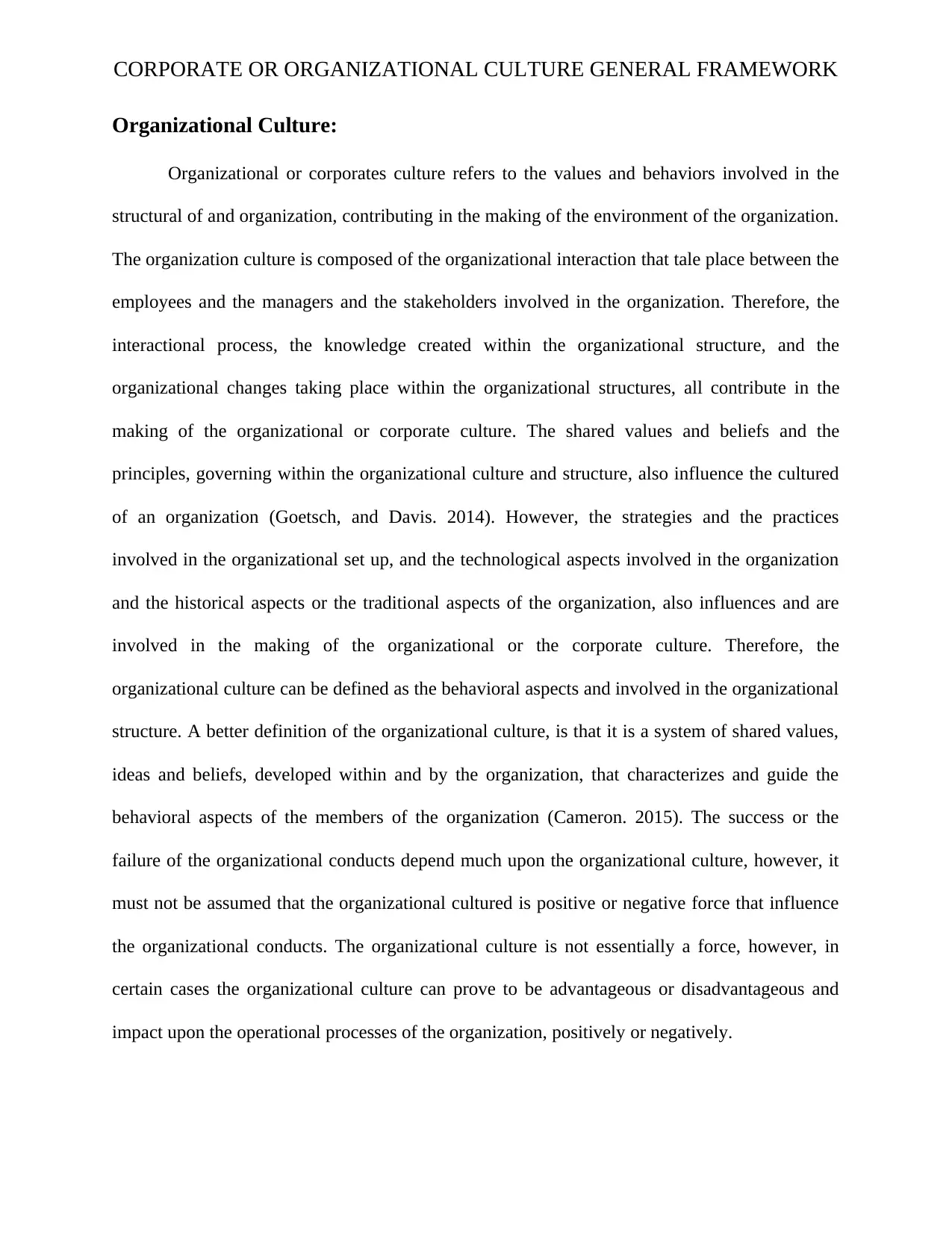
CORPORATE OR ORGANIZATIONAL CULTURE GENERAL FRAMEWORK
Organizational Culture:
Organizational or corporates culture refers to the values and behaviors involved in the
structural of and organization, contributing in the making of the environment of the organization.
The organization culture is composed of the organizational interaction that tale place between the
employees and the managers and the stakeholders involved in the organization. Therefore, the
interactional process, the knowledge created within the organizational structure, and the
organizational changes taking place within the organizational structures, all contribute in the
making of the organizational or corporate culture. The shared values and beliefs and the
principles, governing within the organizational culture and structure, also influence the cultured
of an organization (Goetsch, and Davis. 2014). However, the strategies and the practices
involved in the organizational set up, and the technological aspects involved in the organization
and the historical aspects or the traditional aspects of the organization, also influences and are
involved in the making of the organizational or the corporate culture. Therefore, the
organizational culture can be defined as the behavioral aspects and involved in the organizational
structure. A better definition of the organizational culture, is that it is a system of shared values,
ideas and beliefs, developed within and by the organization, that characterizes and guide the
behavioral aspects of the members of the organization (Cameron. 2015). The success or the
failure of the organizational conducts depend much upon the organizational culture, however, it
must not be assumed that the organizational cultured is positive or negative force that influence
the organizational conducts. The organizational culture is not essentially a force, however, in
certain cases the organizational culture can prove to be advantageous or disadvantageous and
impact upon the operational processes of the organization, positively or negatively.
Organizational Culture:
Organizational or corporates culture refers to the values and behaviors involved in the
structural of and organization, contributing in the making of the environment of the organization.
The organization culture is composed of the organizational interaction that tale place between the
employees and the managers and the stakeholders involved in the organization. Therefore, the
interactional process, the knowledge created within the organizational structure, and the
organizational changes taking place within the organizational structures, all contribute in the
making of the organizational or corporate culture. The shared values and beliefs and the
principles, governing within the organizational culture and structure, also influence the cultured
of an organization (Goetsch, and Davis. 2014). However, the strategies and the practices
involved in the organizational set up, and the technological aspects involved in the organization
and the historical aspects or the traditional aspects of the organization, also influences and are
involved in the making of the organizational or the corporate culture. Therefore, the
organizational culture can be defined as the behavioral aspects and involved in the organizational
structure. A better definition of the organizational culture, is that it is a system of shared values,
ideas and beliefs, developed within and by the organization, that characterizes and guide the
behavioral aspects of the members of the organization (Cameron. 2015). The success or the
failure of the organizational conducts depend much upon the organizational culture, however, it
must not be assumed that the organizational cultured is positive or negative force that influence
the organizational conducts. The organizational culture is not essentially a force, however, in
certain cases the organizational culture can prove to be advantageous or disadvantageous and
impact upon the operational processes of the organization, positively or negatively.
Paraphrase This Document
Need a fresh take? Get an instant paraphrase of this document with our AI Paraphraser
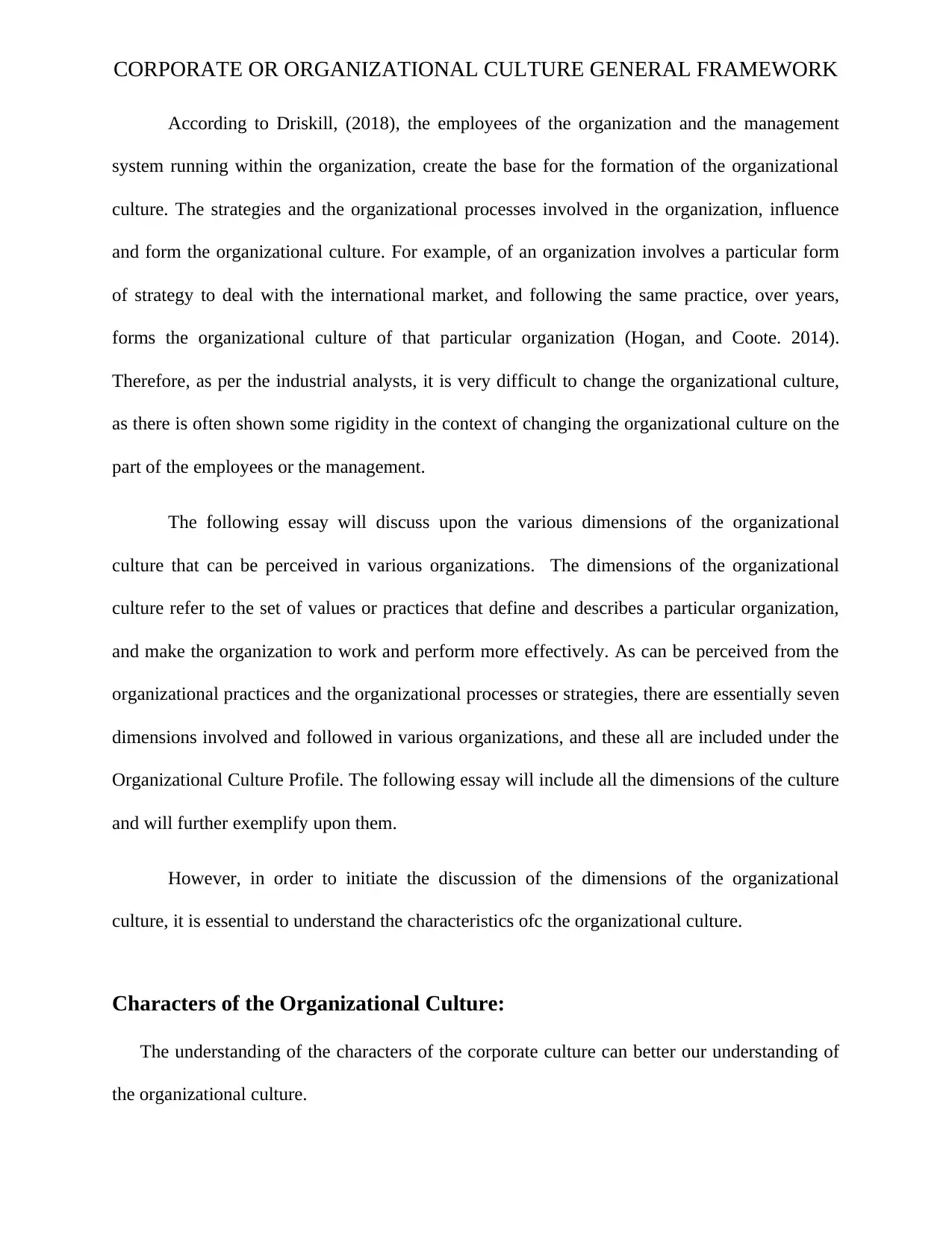
CORPORATE OR ORGANIZATIONAL CULTURE GENERAL FRAMEWORK
According to Driskill, (2018), the employees of the organization and the management
system running within the organization, create the base for the formation of the organizational
culture. The strategies and the organizational processes involved in the organization, influence
and form the organizational culture. For example, of an organization involves a particular form
of strategy to deal with the international market, and following the same practice, over years,
forms the organizational culture of that particular organization (Hogan, and Coote. 2014).
Therefore, as per the industrial analysts, it is very difficult to change the organizational culture,
as there is often shown some rigidity in the context of changing the organizational culture on the
part of the employees or the management.
The following essay will discuss upon the various dimensions of the organizational
culture that can be perceived in various organizations. The dimensions of the organizational
culture refer to the set of values or practices that define and describes a particular organization,
and make the organization to work and perform more effectively. As can be perceived from the
organizational practices and the organizational processes or strategies, there are essentially seven
dimensions involved and followed in various organizations, and these all are included under the
Organizational Culture Profile. The following essay will include all the dimensions of the culture
and will further exemplify upon them.
However, in order to initiate the discussion of the dimensions of the organizational
culture, it is essential to understand the characteristics ofc the organizational culture.
Characters of the Organizational Culture:
The understanding of the characters of the corporate culture can better our understanding of
the organizational culture.
According to Driskill, (2018), the employees of the organization and the management
system running within the organization, create the base for the formation of the organizational
culture. The strategies and the organizational processes involved in the organization, influence
and form the organizational culture. For example, of an organization involves a particular form
of strategy to deal with the international market, and following the same practice, over years,
forms the organizational culture of that particular organization (Hogan, and Coote. 2014).
Therefore, as per the industrial analysts, it is very difficult to change the organizational culture,
as there is often shown some rigidity in the context of changing the organizational culture on the
part of the employees or the management.
The following essay will discuss upon the various dimensions of the organizational
culture that can be perceived in various organizations. The dimensions of the organizational
culture refer to the set of values or practices that define and describes a particular organization,
and make the organization to work and perform more effectively. As can be perceived from the
organizational practices and the organizational processes or strategies, there are essentially seven
dimensions involved and followed in various organizations, and these all are included under the
Organizational Culture Profile. The following essay will include all the dimensions of the culture
and will further exemplify upon them.
However, in order to initiate the discussion of the dimensions of the organizational
culture, it is essential to understand the characteristics ofc the organizational culture.
Characters of the Organizational Culture:
The understanding of the characters of the corporate culture can better our understanding of
the organizational culture.
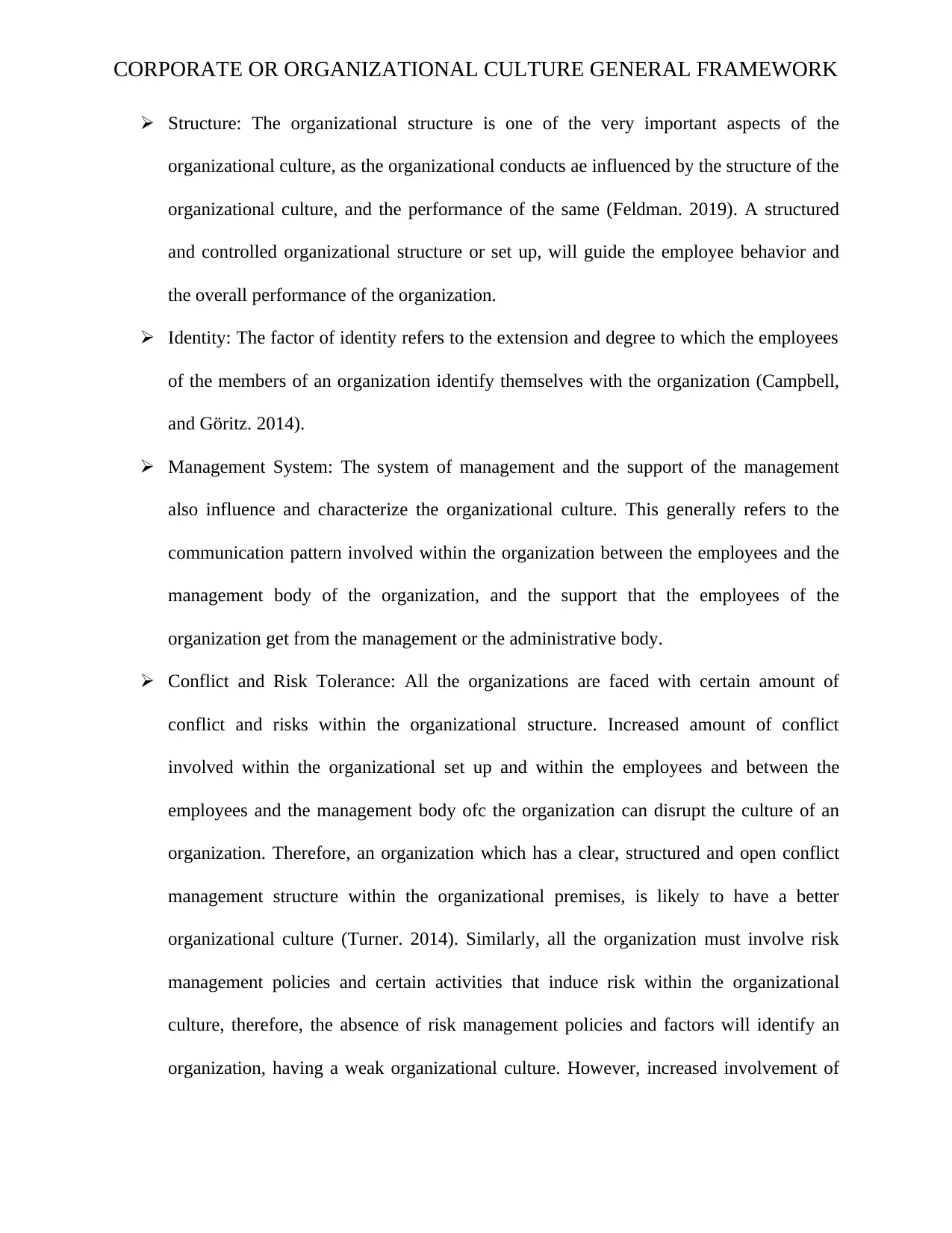
CORPORATE OR ORGANIZATIONAL CULTURE GENERAL FRAMEWORK
Structure: The organizational structure is one of the very important aspects of the
organizational culture, as the organizational conducts ae influenced by the structure of the
organizational culture, and the performance of the same (Feldman. 2019). A structured
and controlled organizational structure or set up, will guide the employee behavior and
the overall performance of the organization.
Identity: The factor of identity refers to the extension and degree to which the employees
of the members of an organization identify themselves with the organization (Campbell,
and Göritz. 2014).
Management System: The system of management and the support of the management
also influence and characterize the organizational culture. This generally refers to the
communication pattern involved within the organization between the employees and the
management body of the organization, and the support that the employees of the
organization get from the management or the administrative body.
Conflict and Risk Tolerance: All the organizations are faced with certain amount of
conflict and risks within the organizational structure. Increased amount of conflict
involved within the organizational set up and within the employees and between the
employees and the management body ofc the organization can disrupt the culture of an
organization. Therefore, an organization which has a clear, structured and open conflict
management structure within the organizational premises, is likely to have a better
organizational culture (Turner. 2014). Similarly, all the organization must involve risk
management policies and certain activities that induce risk within the organizational
culture, therefore, the absence of risk management policies and factors will identify an
organization, having a weak organizational culture. However, increased involvement of
Structure: The organizational structure is one of the very important aspects of the
organizational culture, as the organizational conducts ae influenced by the structure of the
organizational culture, and the performance of the same (Feldman. 2019). A structured
and controlled organizational structure or set up, will guide the employee behavior and
the overall performance of the organization.
Identity: The factor of identity refers to the extension and degree to which the employees
of the members of an organization identify themselves with the organization (Campbell,
and Göritz. 2014).
Management System: The system of management and the support of the management
also influence and characterize the organizational culture. This generally refers to the
communication pattern involved within the organization between the employees and the
management body of the organization, and the support that the employees of the
organization get from the management or the administrative body.
Conflict and Risk Tolerance: All the organizations are faced with certain amount of
conflict and risks within the organizational structure. Increased amount of conflict
involved within the organizational set up and within the employees and between the
employees and the management body ofc the organization can disrupt the culture of an
organization. Therefore, an organization which has a clear, structured and open conflict
management structure within the organizational premises, is likely to have a better
organizational culture (Turner. 2014). Similarly, all the organization must involve risk
management policies and certain activities that induce risk within the organizational
culture, therefore, the absence of risk management policies and factors will identify an
organization, having a weak organizational culture. However, increased involvement of
⊘ This is a preview!⊘
Do you want full access?
Subscribe today to unlock all pages.

Trusted by 1+ million students worldwide
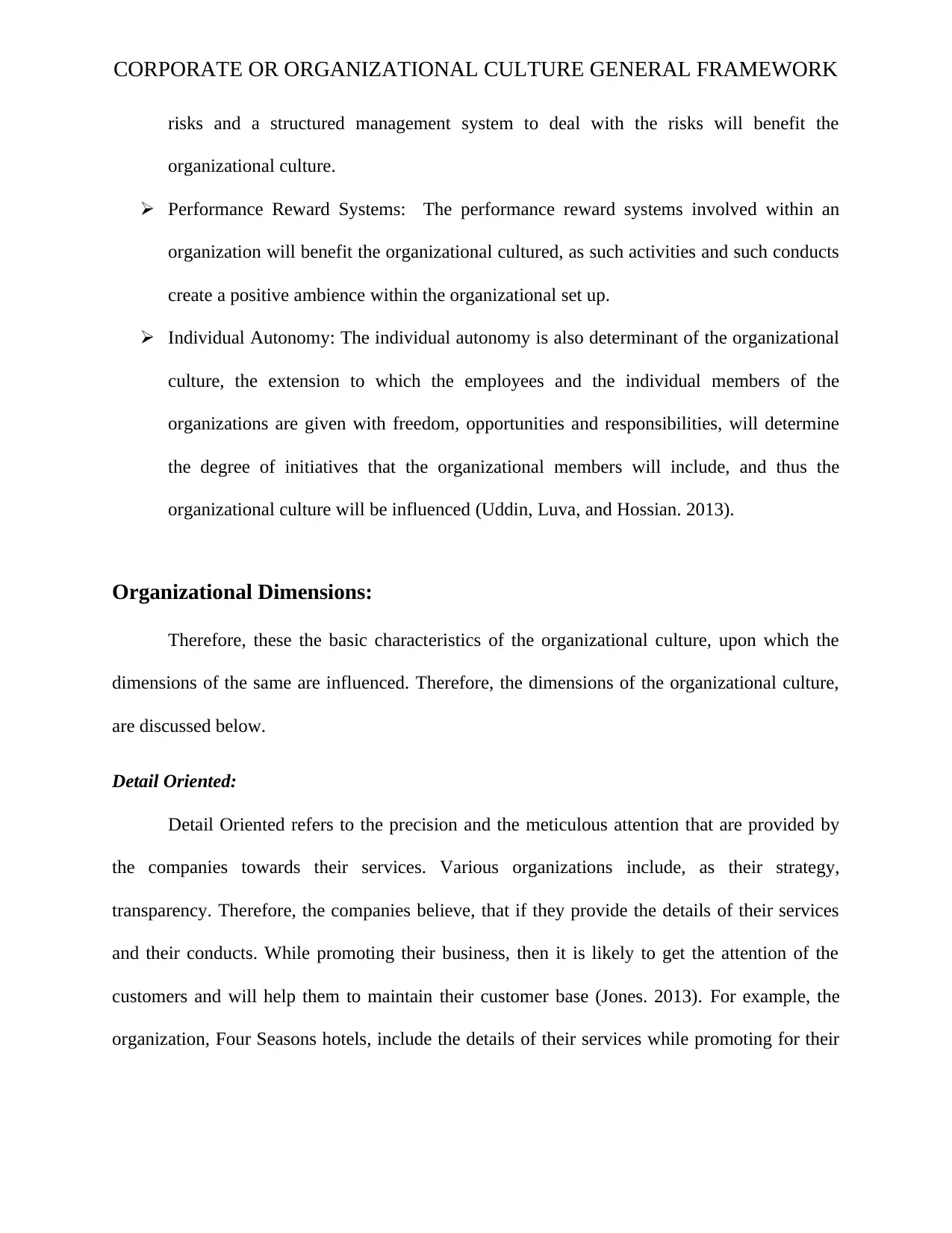
CORPORATE OR ORGANIZATIONAL CULTURE GENERAL FRAMEWORK
risks and a structured management system to deal with the risks will benefit the
organizational culture.
Performance Reward Systems: The performance reward systems involved within an
organization will benefit the organizational cultured, as such activities and such conducts
create a positive ambience within the organizational set up.
Individual Autonomy: The individual autonomy is also determinant of the organizational
culture, the extension to which the employees and the individual members of the
organizations are given with freedom, opportunities and responsibilities, will determine
the degree of initiatives that the organizational members will include, and thus the
organizational culture will be influenced (Uddin, Luva, and Hossian. 2013).
Organizational Dimensions:
Therefore, these the basic characteristics of the organizational culture, upon which the
dimensions of the same are influenced. Therefore, the dimensions of the organizational culture,
are discussed below.
Detail Oriented:
Detail Oriented refers to the precision and the meticulous attention that are provided by
the companies towards their services. Various organizations include, as their strategy,
transparency. Therefore, the companies believe, that if they provide the details of their services
and their conducts. While promoting their business, then it is likely to get the attention of the
customers and will help them to maintain their customer base (Jones. 2013). For example, the
organization, Four Seasons hotels, include the details of their services while promoting for their
risks and a structured management system to deal with the risks will benefit the
organizational culture.
Performance Reward Systems: The performance reward systems involved within an
organization will benefit the organizational cultured, as such activities and such conducts
create a positive ambience within the organizational set up.
Individual Autonomy: The individual autonomy is also determinant of the organizational
culture, the extension to which the employees and the individual members of the
organizations are given with freedom, opportunities and responsibilities, will determine
the degree of initiatives that the organizational members will include, and thus the
organizational culture will be influenced (Uddin, Luva, and Hossian. 2013).
Organizational Dimensions:
Therefore, these the basic characteristics of the organizational culture, upon which the
dimensions of the same are influenced. Therefore, the dimensions of the organizational culture,
are discussed below.
Detail Oriented:
Detail Oriented refers to the precision and the meticulous attention that are provided by
the companies towards their services. Various organizations include, as their strategy,
transparency. Therefore, the companies believe, that if they provide the details of their services
and their conducts. While promoting their business, then it is likely to get the attention of the
customers and will help them to maintain their customer base (Jones. 2013). For example, the
organization, Four Seasons hotels, include the details of their services while promoting for their
Paraphrase This Document
Need a fresh take? Get an instant paraphrase of this document with our AI Paraphraser
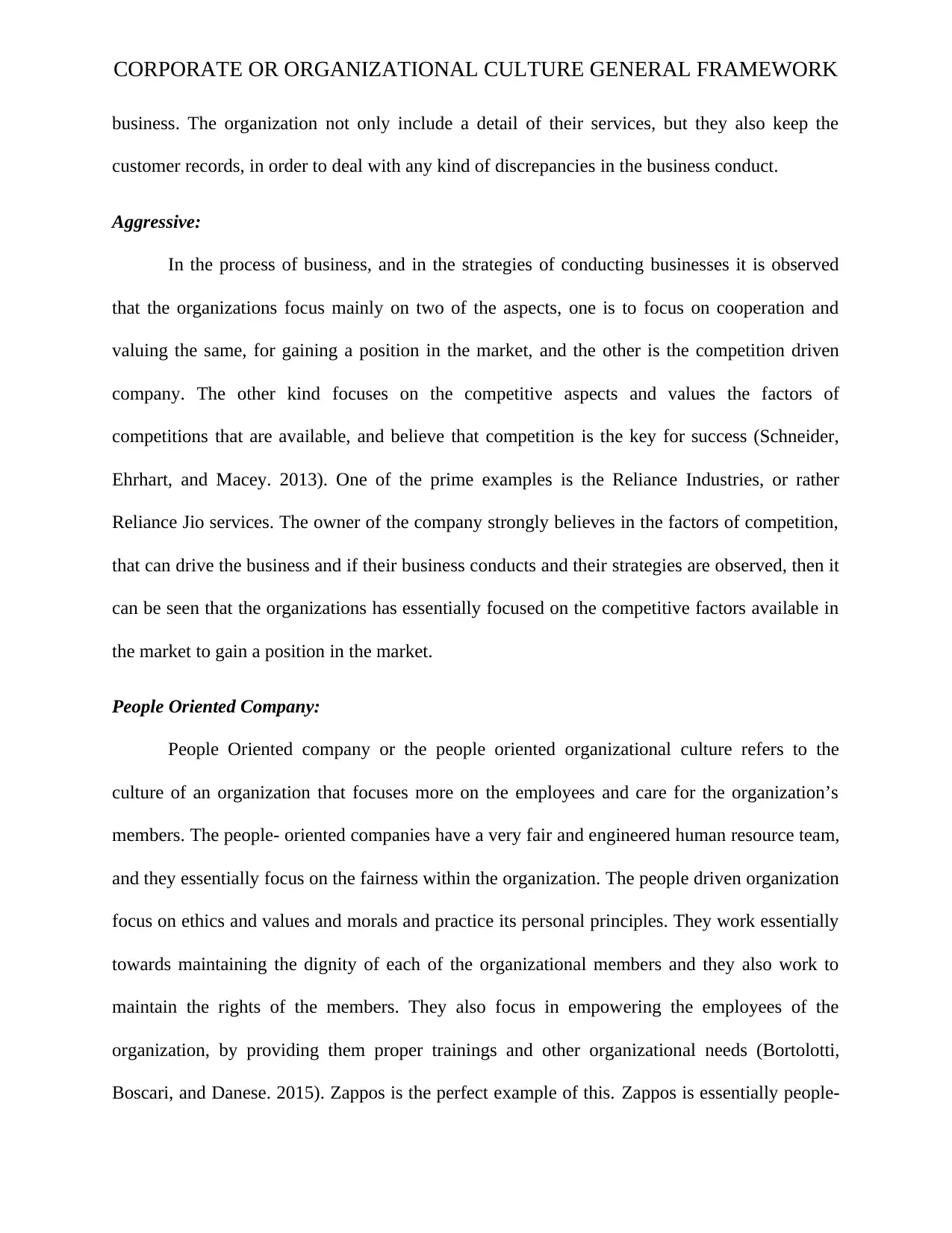
CORPORATE OR ORGANIZATIONAL CULTURE GENERAL FRAMEWORK
business. The organization not only include a detail of their services, but they also keep the
customer records, in order to deal with any kind of discrepancies in the business conduct.
Aggressive:
In the process of business, and in the strategies of conducting businesses it is observed
that the organizations focus mainly on two of the aspects, one is to focus on cooperation and
valuing the same, for gaining a position in the market, and the other is the competition driven
company. The other kind focuses on the competitive aspects and values the factors of
competitions that are available, and believe that competition is the key for success (Schneider,
Ehrhart, and Macey. 2013). One of the prime examples is the Reliance Industries, or rather
Reliance Jio services. The owner of the company strongly believes in the factors of competition,
that can drive the business and if their business conducts and their strategies are observed, then it
can be seen that the organizations has essentially focused on the competitive factors available in
the market to gain a position in the market.
People Oriented Company:
People Oriented company or the people oriented organizational culture refers to the
culture of an organization that focuses more on the employees and care for the organization’s
members. The people- oriented companies have a very fair and engineered human resource team,
and they essentially focus on the fairness within the organization. The people driven organization
focus on ethics and values and morals and practice its personal principles. They work essentially
towards maintaining the dignity of each of the organizational members and they also work to
maintain the rights of the members. They also focus in empowering the employees of the
organization, by providing them proper trainings and other organizational needs (Bortolotti,
Boscari, and Danese. 2015). Zappos is the perfect example of this. Zappos is essentially people-
business. The organization not only include a detail of their services, but they also keep the
customer records, in order to deal with any kind of discrepancies in the business conduct.
Aggressive:
In the process of business, and in the strategies of conducting businesses it is observed
that the organizations focus mainly on two of the aspects, one is to focus on cooperation and
valuing the same, for gaining a position in the market, and the other is the competition driven
company. The other kind focuses on the competitive aspects and values the factors of
competitions that are available, and believe that competition is the key for success (Schneider,
Ehrhart, and Macey. 2013). One of the prime examples is the Reliance Industries, or rather
Reliance Jio services. The owner of the company strongly believes in the factors of competition,
that can drive the business and if their business conducts and their strategies are observed, then it
can be seen that the organizations has essentially focused on the competitive factors available in
the market to gain a position in the market.
People Oriented Company:
People Oriented company or the people oriented organizational culture refers to the
culture of an organization that focuses more on the employees and care for the organization’s
members. The people- oriented companies have a very fair and engineered human resource team,
and they essentially focus on the fairness within the organization. The people driven organization
focus on ethics and values and morals and practice its personal principles. They work essentially
towards maintaining the dignity of each of the organizational members and they also work to
maintain the rights of the members. They also focus in empowering the employees of the
organization, by providing them proper trainings and other organizational needs (Bortolotti,
Boscari, and Danese. 2015). Zappos is the perfect example of this. Zappos is essentially people-
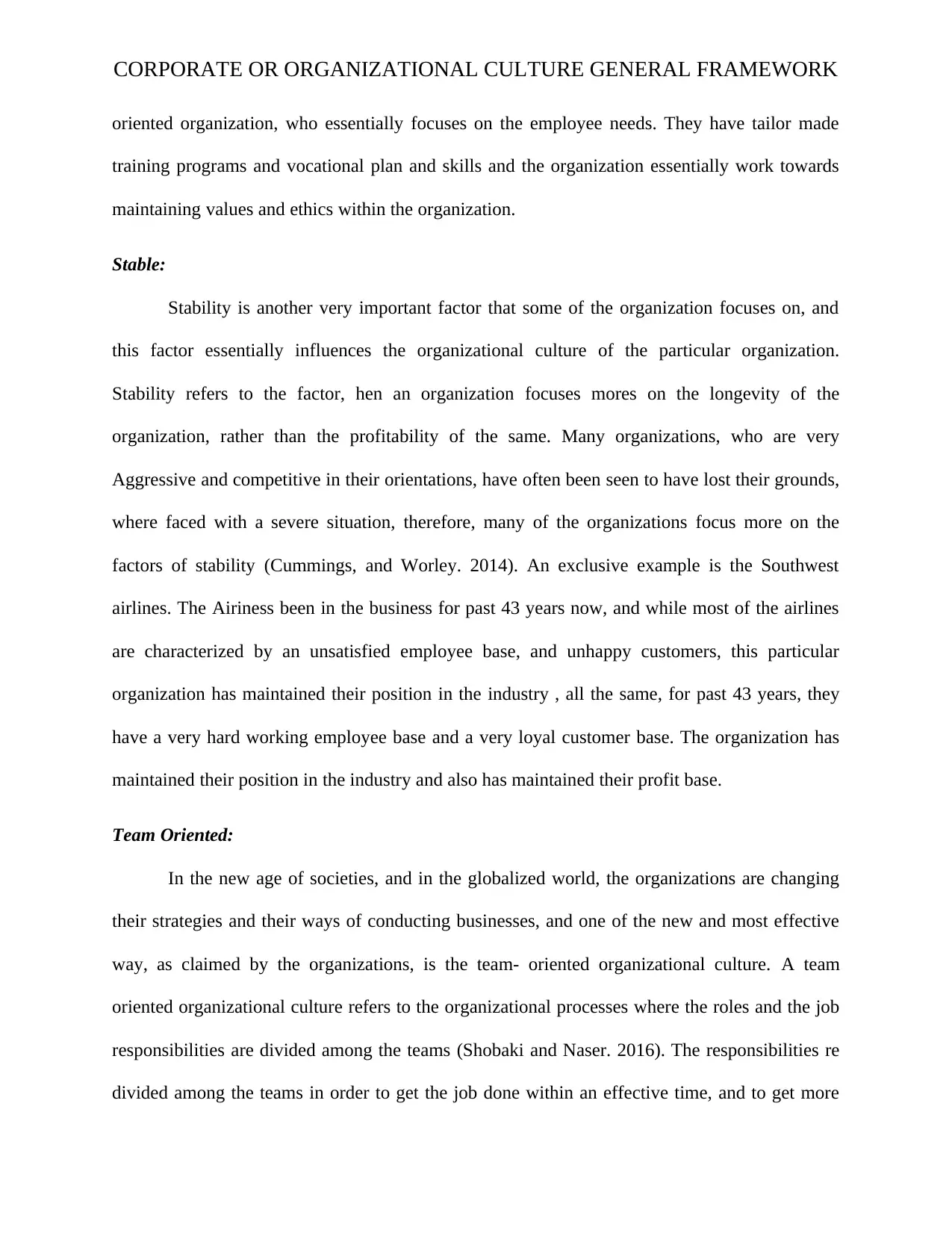
CORPORATE OR ORGANIZATIONAL CULTURE GENERAL FRAMEWORK
oriented organization, who essentially focuses on the employee needs. They have tailor made
training programs and vocational plan and skills and the organization essentially work towards
maintaining values and ethics within the organization.
Stable:
Stability is another very important factor that some of the organization focuses on, and
this factor essentially influences the organizational culture of the particular organization.
Stability refers to the factor, hen an organization focuses mores on the longevity of the
organization, rather than the profitability of the same. Many organizations, who are very
Aggressive and competitive in their orientations, have often been seen to have lost their grounds,
where faced with a severe situation, therefore, many of the organizations focus more on the
factors of stability (Cummings, and Worley. 2014). An exclusive example is the Southwest
airlines. The Airiness been in the business for past 43 years now, and while most of the airlines
are characterized by an unsatisfied employee base, and unhappy customers, this particular
organization has maintained their position in the industry , all the same, for past 43 years, they
have a very hard working employee base and a very loyal customer base. The organization has
maintained their position in the industry and also has maintained their profit base.
Team Oriented:
In the new age of societies, and in the globalized world, the organizations are changing
their strategies and their ways of conducting businesses, and one of the new and most effective
way, as claimed by the organizations, is the team- oriented organizational culture. A team
oriented organizational culture refers to the organizational processes where the roles and the job
responsibilities are divided among the teams (Shobaki and Naser. 2016). The responsibilities re
divided among the teams in order to get the job done within an effective time, and to get more
oriented organization, who essentially focuses on the employee needs. They have tailor made
training programs and vocational plan and skills and the organization essentially work towards
maintaining values and ethics within the organization.
Stable:
Stability is another very important factor that some of the organization focuses on, and
this factor essentially influences the organizational culture of the particular organization.
Stability refers to the factor, hen an organization focuses mores on the longevity of the
organization, rather than the profitability of the same. Many organizations, who are very
Aggressive and competitive in their orientations, have often been seen to have lost their grounds,
where faced with a severe situation, therefore, many of the organizations focus more on the
factors of stability (Cummings, and Worley. 2014). An exclusive example is the Southwest
airlines. The Airiness been in the business for past 43 years now, and while most of the airlines
are characterized by an unsatisfied employee base, and unhappy customers, this particular
organization has maintained their position in the industry , all the same, for past 43 years, they
have a very hard working employee base and a very loyal customer base. The organization has
maintained their position in the industry and also has maintained their profit base.
Team Oriented:
In the new age of societies, and in the globalized world, the organizations are changing
their strategies and their ways of conducting businesses, and one of the new and most effective
way, as claimed by the organizations, is the team- oriented organizational culture. A team
oriented organizational culture refers to the organizational processes where the roles and the job
responsibilities are divided among the teams (Shobaki and Naser. 2016). The responsibilities re
divided among the teams in order to get the job done within an effective time, and to get more
⊘ This is a preview!⊘
Do you want full access?
Subscribe today to unlock all pages.

Trusted by 1+ million students worldwide
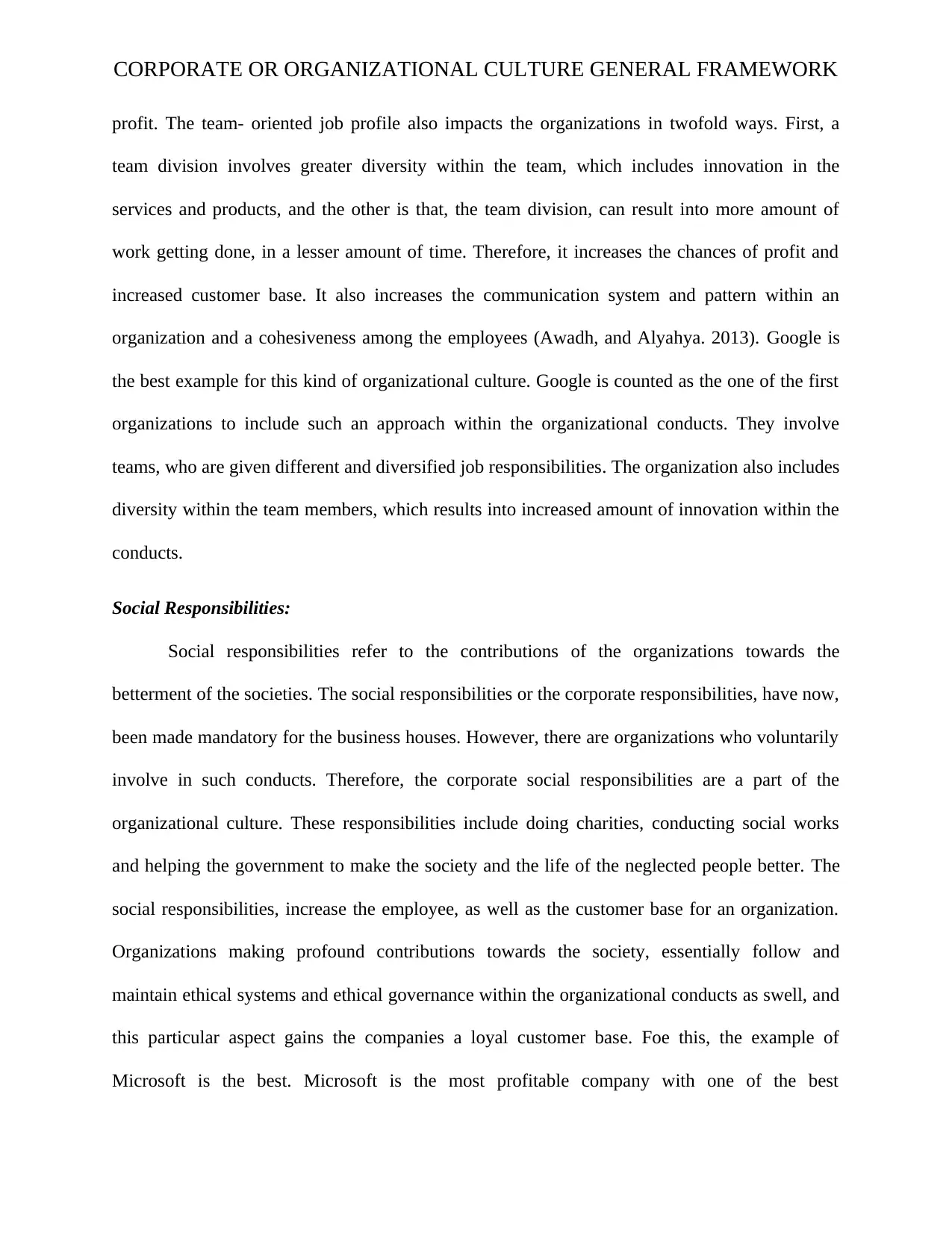
CORPORATE OR ORGANIZATIONAL CULTURE GENERAL FRAMEWORK
profit. The team- oriented job profile also impacts the organizations in twofold ways. First, a
team division involves greater diversity within the team, which includes innovation in the
services and products, and the other is that, the team division, can result into more amount of
work getting done, in a lesser amount of time. Therefore, it increases the chances of profit and
increased customer base. It also increases the communication system and pattern within an
organization and a cohesiveness among the employees (Awadh, and Alyahya. 2013). Google is
the best example for this kind of organizational culture. Google is counted as the one of the first
organizations to include such an approach within the organizational conducts. They involve
teams, who are given different and diversified job responsibilities. The organization also includes
diversity within the team members, which results into increased amount of innovation within the
conducts.
Social Responsibilities:
Social responsibilities refer to the contributions of the organizations towards the
betterment of the societies. The social responsibilities or the corporate responsibilities, have now,
been made mandatory for the business houses. However, there are organizations who voluntarily
involve in such conducts. Therefore, the corporate social responsibilities are a part of the
organizational culture. These responsibilities include doing charities, conducting social works
and helping the government to make the society and the life of the neglected people better. The
social responsibilities, increase the employee, as well as the customer base for an organization.
Organizations making profound contributions towards the society, essentially follow and
maintain ethical systems and ethical governance within the organizational conducts as swell, and
this particular aspect gains the companies a loyal customer base. Foe this, the example of
Microsoft is the best. Microsoft is the most profitable company with one of the best
profit. The team- oriented job profile also impacts the organizations in twofold ways. First, a
team division involves greater diversity within the team, which includes innovation in the
services and products, and the other is that, the team division, can result into more amount of
work getting done, in a lesser amount of time. Therefore, it increases the chances of profit and
increased customer base. It also increases the communication system and pattern within an
organization and a cohesiveness among the employees (Awadh, and Alyahya. 2013). Google is
the best example for this kind of organizational culture. Google is counted as the one of the first
organizations to include such an approach within the organizational conducts. They involve
teams, who are given different and diversified job responsibilities. The organization also includes
diversity within the team members, which results into increased amount of innovation within the
conducts.
Social Responsibilities:
Social responsibilities refer to the contributions of the organizations towards the
betterment of the societies. The social responsibilities or the corporate responsibilities, have now,
been made mandatory for the business houses. However, there are organizations who voluntarily
involve in such conducts. Therefore, the corporate social responsibilities are a part of the
organizational culture. These responsibilities include doing charities, conducting social works
and helping the government to make the society and the life of the neglected people better. The
social responsibilities, increase the employee, as well as the customer base for an organization.
Organizations making profound contributions towards the society, essentially follow and
maintain ethical systems and ethical governance within the organizational conducts as swell, and
this particular aspect gains the companies a loyal customer base. Foe this, the example of
Microsoft is the best. Microsoft is the most profitable company with one of the best
Paraphrase This Document
Need a fresh take? Get an instant paraphrase of this document with our AI Paraphraser
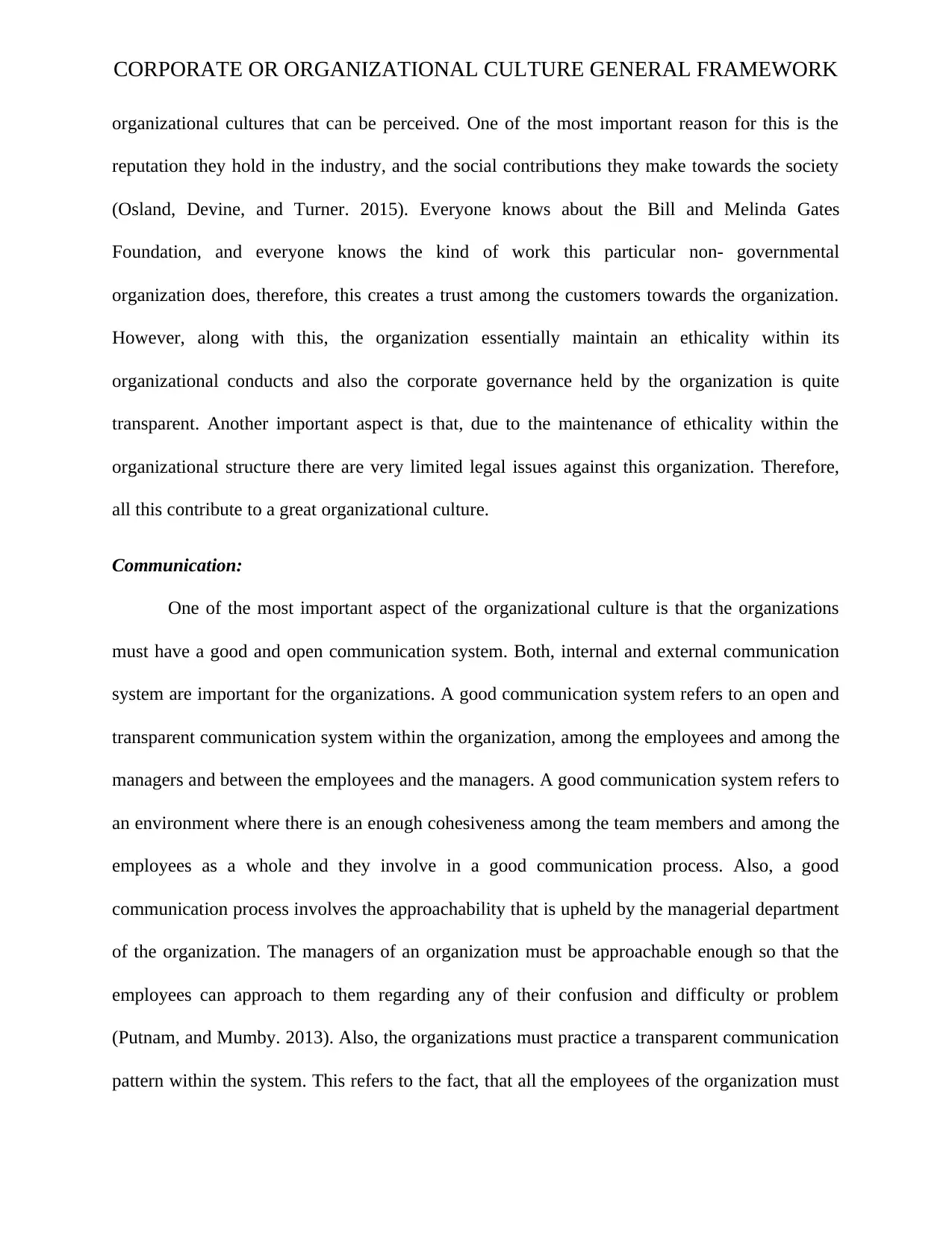
CORPORATE OR ORGANIZATIONAL CULTURE GENERAL FRAMEWORK
organizational cultures that can be perceived. One of the most important reason for this is the
reputation they hold in the industry, and the social contributions they make towards the society
(Osland, Devine, and Turner. 2015). Everyone knows about the Bill and Melinda Gates
Foundation, and everyone knows the kind of work this particular non- governmental
organization does, therefore, this creates a trust among the customers towards the organization.
However, along with this, the organization essentially maintain an ethicality within its
organizational conducts and also the corporate governance held by the organization is quite
transparent. Another important aspect is that, due to the maintenance of ethicality within the
organizational structure there are very limited legal issues against this organization. Therefore,
all this contribute to a great organizational culture.
Communication:
One of the most important aspect of the organizational culture is that the organizations
must have a good and open communication system. Both, internal and external communication
system are important for the organizations. A good communication system refers to an open and
transparent communication system within the organization, among the employees and among the
managers and between the employees and the managers. A good communication system refers to
an environment where there is an enough cohesiveness among the team members and among the
employees as a whole and they involve in a good communication process. Also, a good
communication process involves the approachability that is upheld by the managerial department
of the organization. The managers of an organization must be approachable enough so that the
employees can approach to them regarding any of their confusion and difficulty or problem
(Putnam, and Mumby. 2013). Also, the organizations must practice a transparent communication
pattern within the system. This refers to the fact, that all the employees of the organization must
organizational cultures that can be perceived. One of the most important reason for this is the
reputation they hold in the industry, and the social contributions they make towards the society
(Osland, Devine, and Turner. 2015). Everyone knows about the Bill and Melinda Gates
Foundation, and everyone knows the kind of work this particular non- governmental
organization does, therefore, this creates a trust among the customers towards the organization.
However, along with this, the organization essentially maintain an ethicality within its
organizational conducts and also the corporate governance held by the organization is quite
transparent. Another important aspect is that, due to the maintenance of ethicality within the
organizational structure there are very limited legal issues against this organization. Therefore,
all this contribute to a great organizational culture.
Communication:
One of the most important aspect of the organizational culture is that the organizations
must have a good and open communication system. Both, internal and external communication
system are important for the organizations. A good communication system refers to an open and
transparent communication system within the organization, among the employees and among the
managers and between the employees and the managers. A good communication system refers to
an environment where there is an enough cohesiveness among the team members and among the
employees as a whole and they involve in a good communication process. Also, a good
communication process involves the approachability that is upheld by the managerial department
of the organization. The managers of an organization must be approachable enough so that the
employees can approach to them regarding any of their confusion and difficulty or problem
(Putnam, and Mumby. 2013). Also, the organizations must practice a transparent communication
pattern within the system. This refers to the fact, that all the employees of the organization must
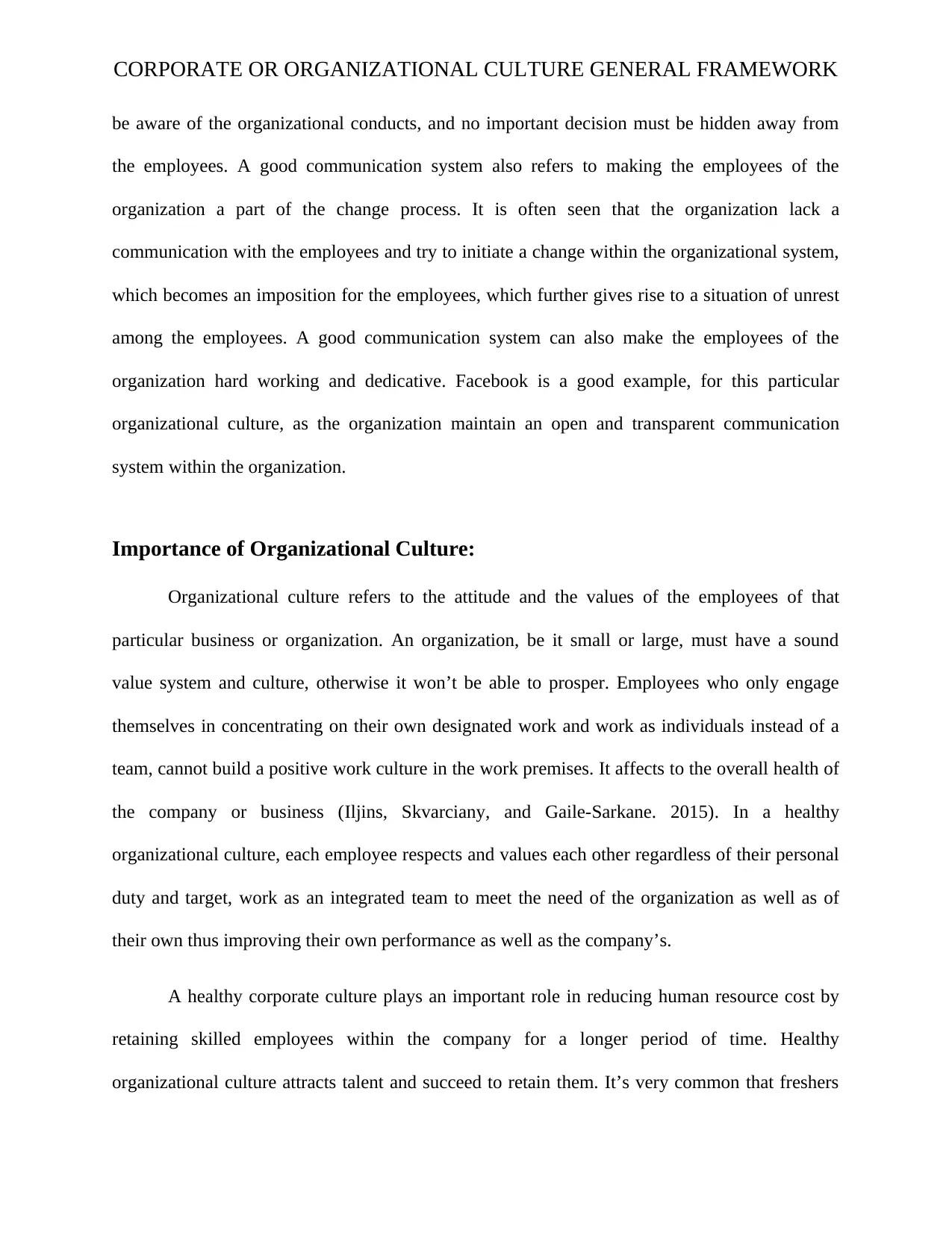
CORPORATE OR ORGANIZATIONAL CULTURE GENERAL FRAMEWORK
be aware of the organizational conducts, and no important decision must be hidden away from
the employees. A good communication system also refers to making the employees of the
organization a part of the change process. It is often seen that the organization lack a
communication with the employees and try to initiate a change within the organizational system,
which becomes an imposition for the employees, which further gives rise to a situation of unrest
among the employees. A good communication system can also make the employees of the
organization hard working and dedicative. Facebook is a good example, for this particular
organizational culture, as the organization maintain an open and transparent communication
system within the organization.
Importance of Organizational Culture:
Organizational culture refers to the attitude and the values of the employees of that
particular business or organization. An organization, be it small or large, must have a sound
value system and culture, otherwise it won’t be able to prosper. Employees who only engage
themselves in concentrating on their own designated work and work as individuals instead of a
team, cannot build a positive work culture in the work premises. It affects to the overall health of
the company or business (Iljins, Skvarciany, and Gaile-Sarkane. 2015). In a healthy
organizational culture, each employee respects and values each other regardless of their personal
duty and target, work as an integrated team to meet the need of the organization as well as of
their own thus improving their own performance as well as the company’s.
A healthy corporate culture plays an important role in reducing human resource cost by
retaining skilled employees within the company for a longer period of time. Healthy
organizational culture attracts talent and succeed to retain them. It’s very common that freshers
be aware of the organizational conducts, and no important decision must be hidden away from
the employees. A good communication system also refers to making the employees of the
organization a part of the change process. It is often seen that the organization lack a
communication with the employees and try to initiate a change within the organizational system,
which becomes an imposition for the employees, which further gives rise to a situation of unrest
among the employees. A good communication system can also make the employees of the
organization hard working and dedicative. Facebook is a good example, for this particular
organizational culture, as the organization maintain an open and transparent communication
system within the organization.
Importance of Organizational Culture:
Organizational culture refers to the attitude and the values of the employees of that
particular business or organization. An organization, be it small or large, must have a sound
value system and culture, otherwise it won’t be able to prosper. Employees who only engage
themselves in concentrating on their own designated work and work as individuals instead of a
team, cannot build a positive work culture in the work premises. It affects to the overall health of
the company or business (Iljins, Skvarciany, and Gaile-Sarkane. 2015). In a healthy
organizational culture, each employee respects and values each other regardless of their personal
duty and target, work as an integrated team to meet the need of the organization as well as of
their own thus improving their own performance as well as the company’s.
A healthy corporate culture plays an important role in reducing human resource cost by
retaining skilled employees within the company for a longer period of time. Healthy
organizational culture attracts talent and succeed to retain them. It’s very common that freshers
⊘ This is a preview!⊘
Do you want full access?
Subscribe today to unlock all pages.

Trusted by 1+ million students worldwide
1 out of 17
Related Documents
Your All-in-One AI-Powered Toolkit for Academic Success.
+13062052269
info@desklib.com
Available 24*7 on WhatsApp / Email
![[object Object]](/_next/static/media/star-bottom.7253800d.svg)
Unlock your academic potential
Copyright © 2020–2025 A2Z Services. All Rights Reserved. Developed and managed by ZUCOL.



![Corporate Governance and Ethics Report: [University Name]](/_next/image/?url=https%3A%2F%2Fdesklib.com%2Fmedia%2Fimages%2Fxn%2F3c55d29f50c44e168436c76554bbf9af.jpg&w=256&q=75)
